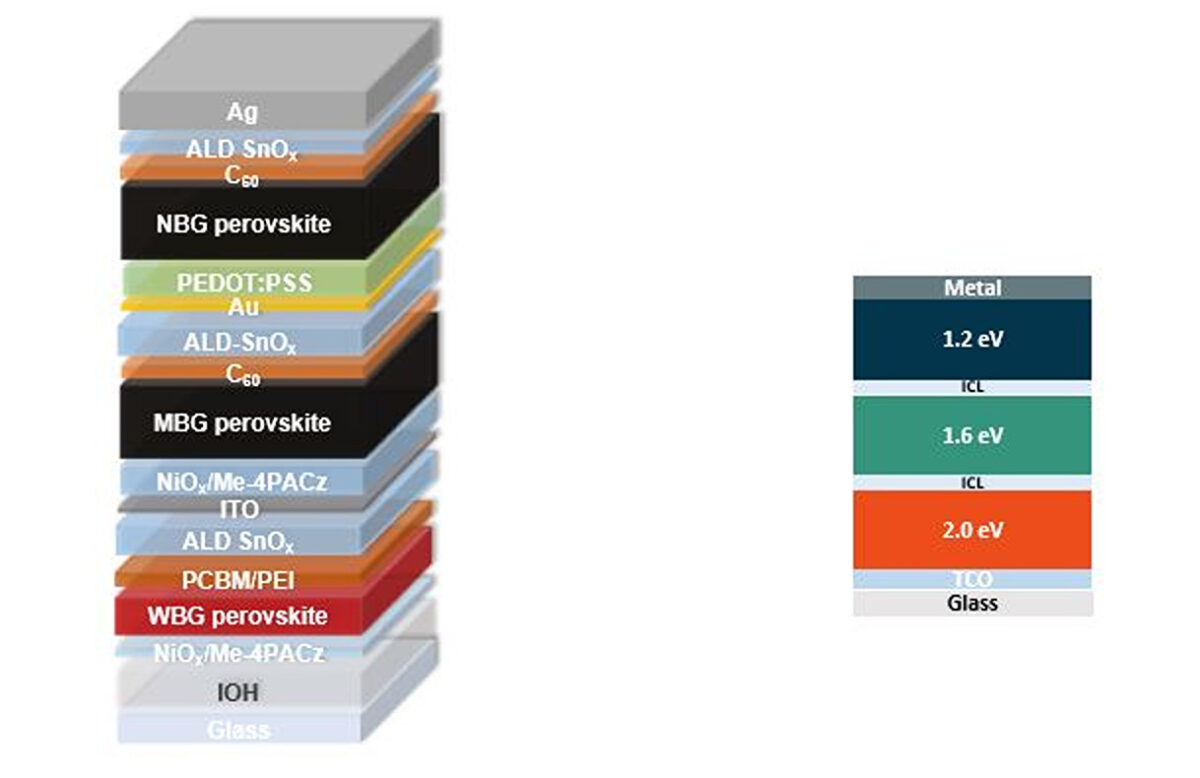An international group of researchers led by the University of Toronto in Canada has developed an all-perovskite triple-junction solar cell that reportedly shows improved homogenization of the halide perovskite film.
The scientists said their new strategy to improve the film quality and the cell efficiency was intended to overcome a typical challenge of monolithic all-perovskite triple-junction PV devices, which usually exhibit increased band offset with charge transport layers and defect density in the wide-bandgap perovskite absorbers. This keeps their efficiencies at lower levels than those achieved by their double-junction and single-junction counterparts.
“We sought to improve bulk and interfacial halide homogeneity in bromium-rich 2 eV wide-bandgap perovskite absorber to reduce energetic losses,” the research corresponding author, Edward Sargent, told pv magazine.
Their approach consisted of a dual bulk and interface passivation technique aimed at promoting halide homogeneity at the interface between the perovskite absorber and the hole-transport-layer (HTL). It involves the introduction of a diammonium halide salt known as propane-1,3-diammonium iodide (PDA) during film formation.
The cell had an area of 0.049 cm2 and an inverted configuration. Inverted perovskite cells have a device structure known as “p-i-n”, in which hole-selective contact p is at the bottom of intrinsic perovskite layer i with electron transport layer n at the top.
The device was designed with a glass substrate, a hydrogen-doped indium oxide (IOH) transparent back contact, a hole transport layer (HTL) made of nickel(II) oxide (NiOx) and phosphonic acid called methyl-substituted carbazole (Me-4PACz), a wide-bandgap perovskite absorber, a spacer based on phenyl-C61-butyric acid methyl ester (PCBM) and polyethylenimine (PEI), a tin oxide (SnOx) buffer layer, an indium tin oxide (ITO) layer, another HTL based on NiOx and Me-4PAC, a mid-bandgap perovskite absorber, a buckminsterfullerene (C60) electron transport layer (ETL), another SnOx buffer layer, a gold (Au) metal contact, another HTL based on the polymer PEDOT:PSS, a narrow-bandgap perovskite absorber, an ETL made of C60, another SnOx buffer layer, and a silver (Ag) metal contact.
The energy bandgap of the three absorbers was 1.97 eV, 1.61 eV, and 1.25 eV, respectively.
Popular content
The researchers said that PDA was found to be effective in interacting with the perovskite precursors and slowing the formation of perovskite films during spin coating, with the films exhibiting delayed crystallization. “We thus speculate that PDA enables controlled growth among halide species and facilitates homogeneous transformation to intermixed perovskite phases,” they explained. “PDA cations bind strongly to the interfaces of adjacent perovskite fragments, allowing more relaxation time for different halide ions to exchange and thereby the formation of uniform mixed-halide perovskite phases.”
Tested under standard illumination conditions, the triple-junction device showed a power conversion efficiency of 25.1%, an open-circuit voltage of 3.33 V, a short-circuit current of 9.7 mA cm2, and a fill factor of 0.78. The device was also able to retain 80% of its initial efficiency after 200 h of continuous maximum power point tracking (MPPT).
The US Department of Energy's National Renewable Energy Lab (NREL), meanwhile, has certified an efficiency of 23.87% for the device using the asymptotic maximum power scan protocol.
“We observed that while the diammonium salt does not suppress light-induced halide segregation, the wide-bandgap cell retains high operational stability under prolonged illumination, beyond the stability of previous approximately 2 eV cells reported in literature,” the scientists said.
The cell was described in the study “Halide homogenization for low energy loss in 2-eV-bandgap perovskites and increased efficiency in all-perovskite triple-junction solar cells,” published in nature energy. The team included academics from the Eindhoven University of Technology in the Netherlands and the University of Washington in the United States, as well as from the University of Oxford and the University of Cambridge in the United Kingdom.
This content is protected by copyright and may not be reused. If you want to cooperate with us and would like to reuse some of our content, please contact: editors@pv-magazine.com.



1 comment
By submitting this form you agree to pv magazine using your data for the purposes of publishing your comment.
Your personal data will only be disclosed or otherwise transmitted to third parties for the purposes of spam filtering or if this is necessary for technical maintenance of the website. Any other transfer to third parties will not take place unless this is justified on the basis of applicable data protection regulations or if pv magazine is legally obliged to do so.
You may revoke this consent at any time with effect for the future, in which case your personal data will be deleted immediately. Otherwise, your data will be deleted if pv magazine has processed your request or the purpose of data storage is fulfilled.
Further information on data privacy can be found in our Data Protection Policy.